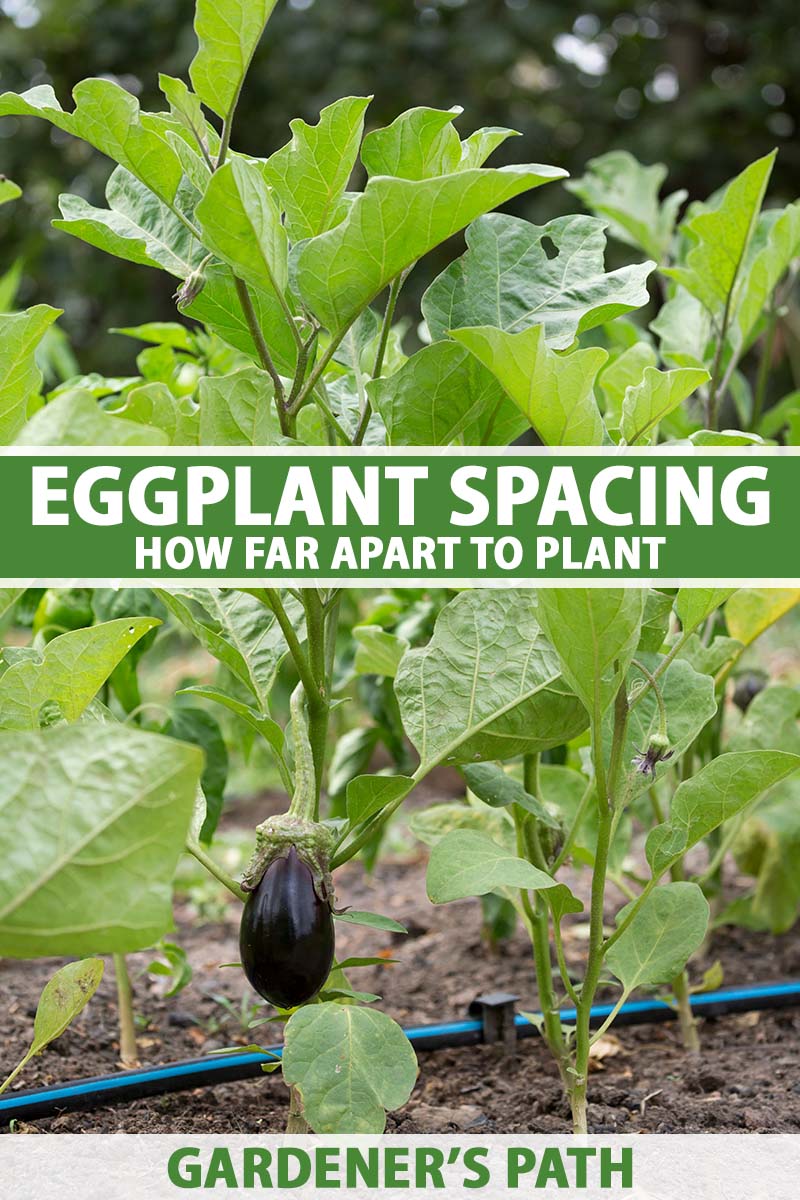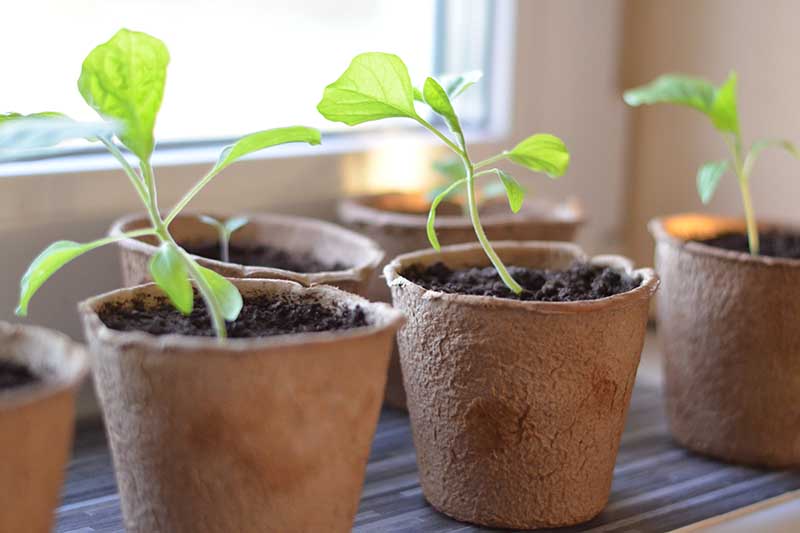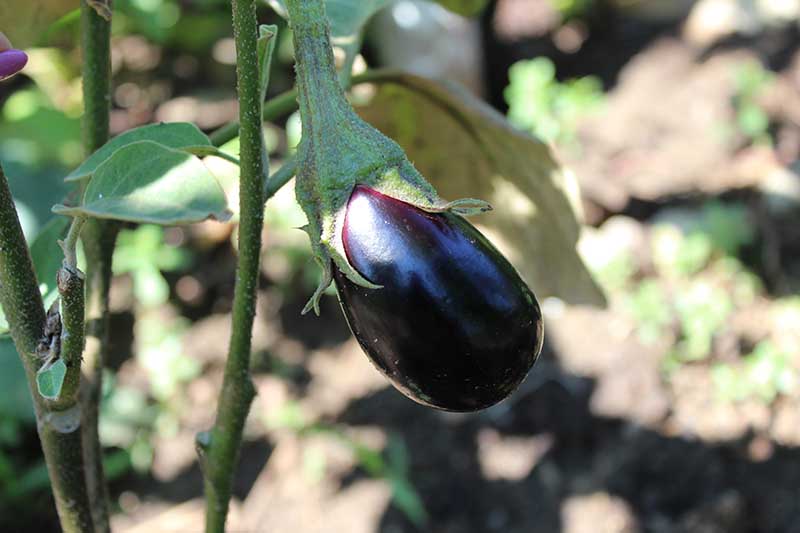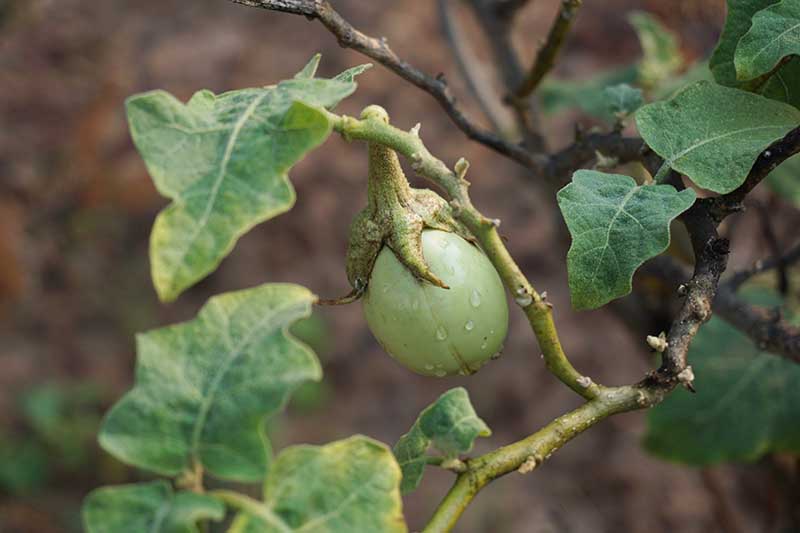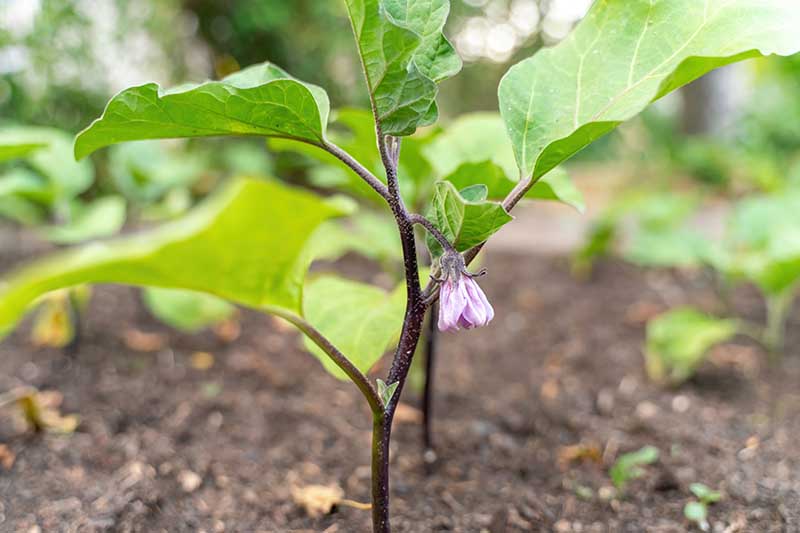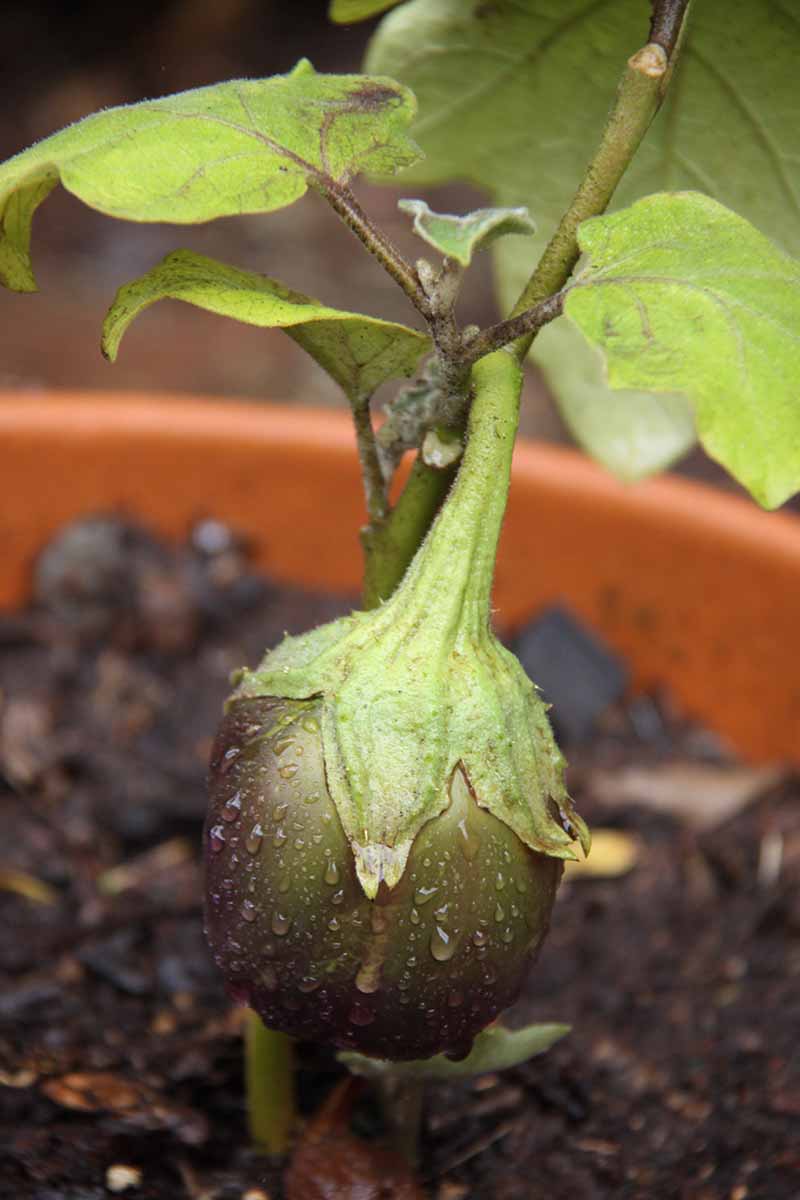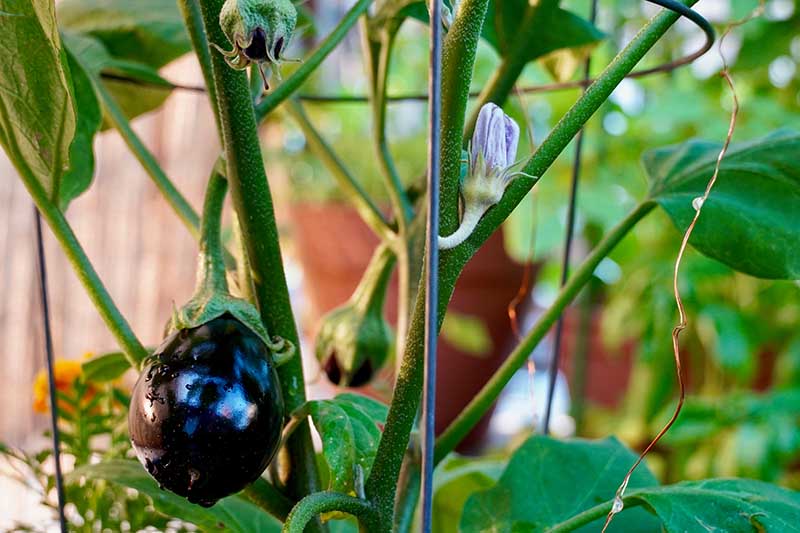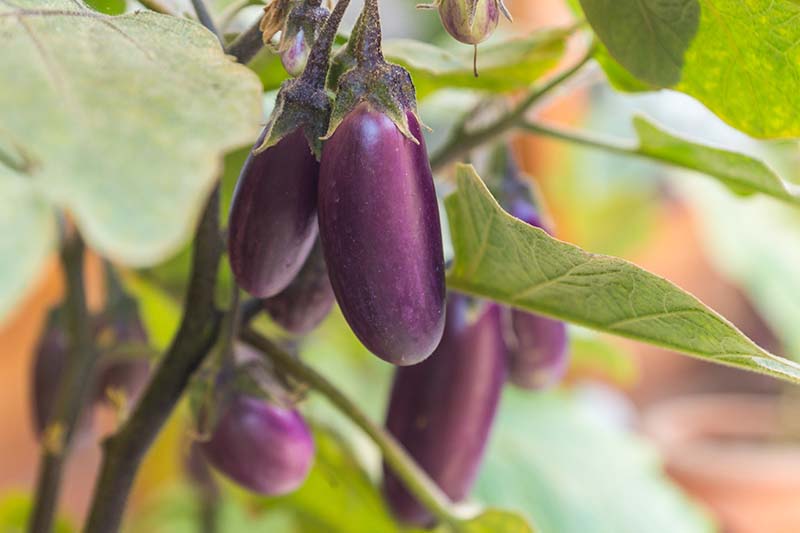While this is an accurate picture of what Solanum melongena may look like in the garden, the reality is that a variety of diverse cultivars exist. Some plants do grow larger fruits, but others produce aubergines the size of your finger. Looking at the plants themselves, some are tall, but others are small. And then there’s the somewhat surprising fact that eggplants are perennials in Zones 10 to 12, and they can grow quite large over the course of a few years.As in, as tall as a basketball player. Wild, right? But if eggplants – also known in English as “aubergines” and “brinjals” – are grown as annuals, they won’t grow nearly as big. We link to vendors to help you find relevant products. If you buy from one of our links, we may earn a commission. But don’t worry – we’ll demystify the rules for spacing in the garden for you. Here’s what we’ll cover:
The Basics
Eggplants are tall, bushy members of the nightshade family, Solanaceae just like peppers and tomatoes. The leaves are wide at the base and pointed at the tip, and in some cultivars they are wavy or toothed. Star-shaped white or purple flowers are self-pollinated with the help of a strong breeze – or a bumblebee practicing buzz pollination. Occasionally, they may need to be hand-pollinated. In Zones 4 through 9, they are grown as annuals. As plants that love warm weather, they tend to perish rather quickly when the first frosts hit. But in Zones 10 to 12, they can thrive as short-lived perennials. They’ll produce heartily for at least two summers, and then production will slow in years three and four. If you live in a growing zone that’s warm enough, why not let them grow as perennials for a few years? You’ll have a head-start on hearty, savory aubergines for at least a few seasons to come. When you’re starting your seeds, which you can learn more about in our guide to growing eggplant, you’ll need to sow them indoors in seedling trays or peat pots, so spacing isn’t an issue until it’s time to transplant them into the garden. Whether you start your own seeds or purchase young plants at a nursery, when you plant them out in your garden or raised bed, you’ll place them somewhere between 18 and 36 inches apart, in rows 30 to 36 inches apart. Keep in mind that row spacing is mostly there to allow you some work space in between plants in a traditional, in-ground garden arranged in rows. You don’t have to stick to this guideline, particularly not if you’re growing your aubergines in a raised bed or square foot garden. In addition to the recommendations above, there’s a different set of rules for growing them in containers. But this is just a starting point. Take a look at the seed packet or plant label to see what the exact recommendations are for whatever particular variety you’re growing. If there’s no information on the seed packet or label, never fear! We’ll cover the best spacing for some of the most common large and small varieties of eggplant here, and then move on to looking at how growing them as annuals or perennials affects the recommended spacing. The best thing for you to do when using this guide at planting time is to check the spacing requirements for your chosen variety, and then head to the “annuals” or “perennials” section below to dig a bit deeper.
Larger and Smaller Varieties
Let’s start with the smaller varieties of S. melongena. Keep in mind that just because a variety produces smaller fruits does not necessarily mean it’s a super-small plant, and vice versa. ‘Patio Baby Mini’ is a beloved cultivar that produces miniature, two- to three-inch fruits. The plants can grow 16 to 20 inches tall and spread 18 to 22 inches, so you’ll want to space them at least 18 to 22 inches apart. If you’re growing these in containers on a patio, plant one aubergine apiece in an 18-inch container. For raised beds, you probably won’t be growing them in rows: just make sure there are 18 to 22 inches of space on all sides of each plant. If you’re growing them in a traditional in-the-ground row garden, space plants 18 to 22 inches apart in rows 30 to 36 inches apart. The classic heirloom, ‘Black Beauty,’ has put many a glossy, dark-purple eggplant on grocery store shelves around the globe. Each fruit is around four to five inches long at maturity, and the plants are surprisingly compact: they grow 18 to 24 inches tall and spread just 16 to 18 inches. For best results, plant them 16 to 18 inches apart. In a classic row garden, space rows 30 inches apart. In square foot gardens, plant each one so that it’s 16 to 18 inches away from other plants on all sides. ‘Shooting Stars,’ a fun cultivar that produces eight-inch-long purple and white speckled fruits, grows just 30 inches tall and spreads 20 inches, so you’re safe to plant these 18 to 20 inches apart in rows 30 inches apart. Many Asian varieties, like ‘Long Asian,’ grow long, slim fruits on compact plants that are 18 to 24 inches tall and 12 to 18 inches wide at maturity, which make them excellent contenders for containers or small gardens. Space them 12 to 18 inches apart in square foot gardens or raised beds. In traditional vegetable gardens arranged in rows, leave 30 inches between each row so that you can move easily between the plants. Now, on to a couple of popular larger varieties: ‘Behold’ is a Burpee hybrid that grows up to three or four feet tall and spreads 30 to 35 inches, so leave a good 30 to 36 inches between each plant. Rows should be at least three feet apart from each other to give the plants plenty of room to stretch and grow. The popular hybrids ‘Hansel’ and ‘Gretel’ may produce diminutive two- to three-inch fruits, but plants can grow 24 to 36 inches tall and wide, so leave at least 24 inches of space between each plant, preferably more, with rows spaced 30 to 36 inches from each other. But here’s a secret about eggplants: since most people don’t grow them as perennials, you can’t quite depend on these numbers when it comes to growing the same plant for two to four years. That’s why the next two sections discuss the differences between spacing eggplants as annuals versus perennials. Those of you in Zones 4-9 can follow the guidelines in the “annuals” section, while all you balmy-clime-dwellers in Zones 10-12 can try your hand at growing aubergines as perennials.
Annuals
Spacing is pretty simple when you’re growing eggplants as annuals. Since they’ve only got one season to spread their green wings, they won’t be growing taller than a teenage kid who eats five bowls of cereal in the morning like perennials are apt to do. So, your starting point is to space them somewhere between 18 and 36 inches apart in rows 24 to 36 inches apart. You’ll want to take a look at the variety you’re growing before making that final call, but if you’re within these parameters your plants will probably be fine, even if they’re rubbing shoulders with their neighbors a little bit. And of course, if you’re working with a square foot garden, a raised bed, or a less formal in-ground garden without rows, just make sure you space plants 18 to 36 inches apart on all sides, depending on the mature spread of your selected varieties. Keep in mind that for any variety that grows 18 inches tall or more, you’ll also probably need to use a tomato cage to help the plant support its fruits.
Perennials
Growing in a warm zone that doesn’t get killing frosts? Lucky you, you’ll get to enjoy aubergines far more often than we lowly eggplants-as-annuals growers! But things get a little trickier when we’re talking about spacing those that are growing as perennials. According to Master Gardener Linda Trujillo, writing for the University of Arizona’s Maricopa County Cooperative Extension, eggplants can grow up to eight feet tall. But the spread is only somewhere between four and six feet, so you “only” need to plant your perennial aubergines four to six feet apart with large, tall tomato cages around each plant.
Container Growing
Maybe you’re not growing these veggies in the ground at all but in containers, which you can learn more about in our container-growing guide. Gardener’s Blue Ribbon Plant Supports These five-foot supports from Gardener’s Blue Ribbon, available at the Home Depot, do the trick quite well. Pro Series Pepper/Eggplant supports from Burpee are another nice option. So you’re prepping to grow a bounty of brinjals, and you want to know: how many can you plant in one container? Your best bet is to plant just one 18- to 36-inch S. melongena in each container. I know, I know, that’s not very many. But hear me out! A smaller variety that grows between 18 and 24 inches tall and wide will require a pot that’s at least 12 to 14 inches wide and deep. All of the larger, 25- to 36-inch types need more room, of course: a container that’s 20 inches wide and deep at the very least. If you have a huge pot – at least 26 inches wide and deep – you may be able to fit two smaller plants inside, spacing them 12 to 14 inches apart. Unless you have a truly gigantic container that’s at least 40 inches wide and deep, you won’t be able to fit two regular-sized aubergines inside. You’re better off planting each in its own pot, and placing them side by side for a visually pleasing eggplant container garden. Each plant will have its own soil to draw water and nutrients from, but you can still fit a few containers in a small-ish space, like a sunny deck or porch. Have you ever grown a crop of eggplants, large or small? We’d love to hear your stories and questions in the comments section below. And for more information about growing eggplant, be sure to check out these articles next:
9 of the Best White Eggplant Varieties21 of the Best Japanese Eggplant Varieties
